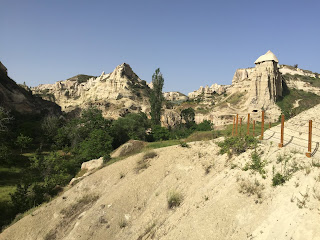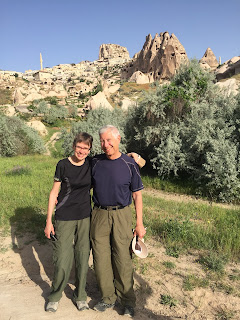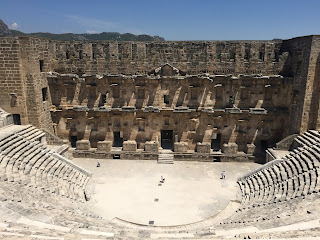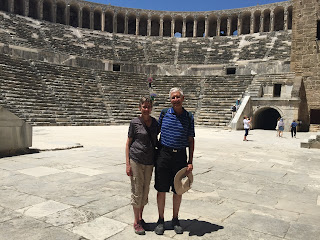Hot air balloon rides at dawn are a big business in Cappadocia. More than 100 balloons launch every morning before the sun rises. It’s pricey and the balloons are big (up to 24 passengers in one basket). We said “no thanks” to that deal. But about three bus loads of Asian tourists staying in our hotel were very excited about it, and they were yelling and whooping in the hallway outside our room at 4 a.m.
So, after trying in vain for an hour to get back to sleep, we got up and went out on our balcony to see the balloons. Only 30-35 were visible from our vantage point, but it was still fun to see. As long as we were up anyway, that is.
At 7 a.m. we again met our group leader and one other member of our group for a hike in the countryside. We took a different trail this time — longer, flatter, and a bit more barren than yesterday.
Just about a block from the hotel we picked up a couple of escorts. Dogs roam freely here, whether owned or stray, so long as they have an ear tag indicating that they have been vaccinated. Perhaps thinking we would lead them to breakfast, these two mutts joined us and stayed with us most of the hike.
The larger one was part Anatolian Shepherd. He stayed behind us to herd us, and he even stuck his nose into the back of my knew once when I stopped to take a picture, urging me to move on and stay with the herd!
The smaller one could have been part Vizsla — in color and temperament, if not by blood. He scouted in front of us, sometimes ranging far and wide like a hunting dog to flush out any birds or other animals in our path.
It was kind of funny, but Mary did not appreciate strange dogs in such close proximity. The dogs mysteriously disappeared about 3 miles into our 3.3 mile hike. They must have finally decided we had nothing for them.
After a shower and breakfast we were on the bus to the ghost town village of Kaymakli. Here we visited one of the more than 300 “underground cities” of Cappadocia. Caves for shelter were dug into this soft rock beginning in the stone ages. But in the early centuries of the Christian era, when Roman patrols came to round up Christians, simple caves were expanded into vast, underground labyrinths.
An entire village could disappear underground, along with much of their livestock. Food was stored to enable survival for long periods. Wineries, grinding mills, churches, communal kitchens, and more were carved into solid rock. In the case of this city, ingeniously hidden ventilation shafts carried fresh air down to seven levels deep. It was amazing.
These cities were used off and on during times of persecution, war, bandit attacks, and other calamities into the Ottoman period, with generation after generation adding spaces as needed. Some of the passages were so small that a few people in our group turned back. These are not cities for the claustrophobic.
From here the bus drove us to the Pasabaglari Natural History Site. This is a formation of stone chimneys — some with dug out caves, others not — that are only slightly unique, but which are protected. We were given an hour free here, but it was blistering hot with very little shade, so most of the group finished early.
In keeping with the underground theme, we ate at a very upscale restaurant that is completely under ground. The proprietors found an area of rock that had not previously been dug, and using modern machinery in 2006, tunneled in deep to create kitchens, storage rooms, and six large dining rooms, all opening into a central, domed atrium. The ambiance was great, the soup and salad pretty average, but the main course was a stew, slow-cooked in a clay pot — a traditional local dish. It was very good.
Following lunch, the group voted unanimously to spend an hour in Goreme, where we had dinner the previous night, in order to see the scenic town in daylight and/or to visit the shops there. Even Mary did a little bit of shopping — just enough to use up our last few Turkish Lira.
After a couple hours of R and R back at the hotel, we took the bus once again to our Farewell Dinner. Ersin did the OAT thing of reviewing the trip in detail, but took forever to do so. The meal was very good, and we even had decent red wine, a first for Turkey.
We catch a plane early in the morning to begin the long trip home.
So, after trying in vain for an hour to get back to sleep, we got up and went out on our balcony to see the balloons. Only 30-35 were visible from our vantage point, but it was still fun to see. As long as we were up anyway, that is.
At 7 a.m. we again met our group leader and one other member of our group for a hike in the countryside. We took a different trail this time — longer, flatter, and a bit more barren than yesterday.
Just about a block from the hotel we picked up a couple of escorts. Dogs roam freely here, whether owned or stray, so long as they have an ear tag indicating that they have been vaccinated. Perhaps thinking we would lead them to breakfast, these two mutts joined us and stayed with us most of the hike.
The larger one was part Anatolian Shepherd. He stayed behind us to herd us, and he even stuck his nose into the back of my knew once when I stopped to take a picture, urging me to move on and stay with the herd!
The smaller one could have been part Vizsla — in color and temperament, if not by blood. He scouted in front of us, sometimes ranging far and wide like a hunting dog to flush out any birds or other animals in our path.
It was kind of funny, but Mary did not appreciate strange dogs in such close proximity. The dogs mysteriously disappeared about 3 miles into our 3.3 mile hike. They must have finally decided we had nothing for them.
After a shower and breakfast we were on the bus to the ghost town village of Kaymakli. Here we visited one of the more than 300 “underground cities” of Cappadocia. Caves for shelter were dug into this soft rock beginning in the stone ages. But in the early centuries of the Christian era, when Roman patrols came to round up Christians, simple caves were expanded into vast, underground labyrinths.
An entire village could disappear underground, along with much of their livestock. Food was stored to enable survival for long periods. Wineries, grinding mills, churches, communal kitchens, and more were carved into solid rock. In the case of this city, ingeniously hidden ventilation shafts carried fresh air down to seven levels deep. It was amazing.
These cities were used off and on during times of persecution, war, bandit attacks, and other calamities into the Ottoman period, with generation after generation adding spaces as needed. Some of the passages were so small that a few people in our group turned back. These are not cities for the claustrophobic.
From here the bus drove us to the Pasabaglari Natural History Site. This is a formation of stone chimneys — some with dug out caves, others not — that are only slightly unique, but which are protected. We were given an hour free here, but it was blistering hot with very little shade, so most of the group finished early.
In keeping with the underground theme, we ate at a very upscale restaurant that is completely under ground. The proprietors found an area of rock that had not previously been dug, and using modern machinery in 2006, tunneled in deep to create kitchens, storage rooms, and six large dining rooms, all opening into a central, domed atrium. The ambiance was great, the soup and salad pretty average, but the main course was a stew, slow-cooked in a clay pot — a traditional local dish. It was very good.
Following lunch, the group voted unanimously to spend an hour in Goreme, where we had dinner the previous night, in order to see the scenic town in daylight and/or to visit the shops there. Even Mary did a little bit of shopping — just enough to use up our last few Turkish Lira.
After a couple hours of R and R back at the hotel, we took the bus once again to our Farewell Dinner. Ersin did the OAT thing of reviewing the trip in detail, but took forever to do so. The meal was very good, and we even had decent red wine, a first for Turkey.
We catch a plane early in the morning to begin the long trip home.


























































